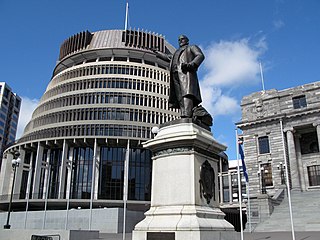
Wellington is the capital city of New Zealand. It is located at the south-western tip of the North Island, between Cook Strait and the Remutaka Range. Wellington is the third-largest city in New Zealand, and is the administrative centre of the Wellington Region. It is the world's southernmost capital of a sovereign state. Wellington features a temperate maritime climate, and is the world's windiest city by average wind speed.

New Zealand Parliament Buildings house the New Zealand Parliament and are on a 45,000 square metre site at the northern end of Lambton Quay, Wellington. From north to south, they are the Parliamentary Library (1899); the Edwardian neoclassical-style Parliament House (1922); the executive wing, called "The Beehive" (1977); and Bowen House, in use since 1991. Whilst most of the individual buildings are outstanding for different reasons, the overall setting that has been achieved "has little aesthetic or architectural coherence".

Oriental Bay is a bay and suburb of Wellington, the capital city of New Zealand. Noted for being both a popular beach and a luxurious centre of affluence in the city, it is located close to the Central Business District on Wellington Harbour.

Sir Ian Charles Athfield was a New Zealand architect. He was born in Christchurch and graduated from the University of Auckland in 1963 with a Diploma of Architecture. That same year he joined Structon Group Architects, and he became a partner in 1965. In 1968 he was a principal partner in setting up Athfield Architects with Ian Dickson and Graeme John Boucher (Manson). Athfield died in 2015 due to complications from a routine procedure which resulted in pneumonia, at the Wellington Hospital, where he was being treated for prostate cancer.
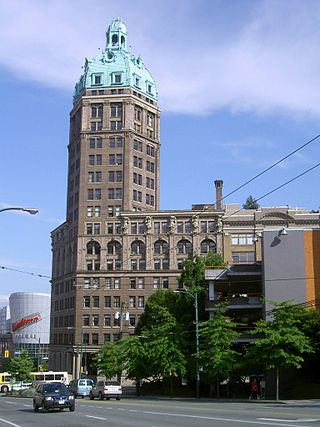
The Sun Tower is a 17 storey 82 m (269 ft) Beaux-Arts building at 128 West Pender Street in Vancouver, British Columbia. It was known for its faux-patina steel dome painted to imitate copper cladding. In early February 2021 a newly finished roof clad in real penny-coloured copper tiles was revealed. The new roof was a part of restoration work that began on the heritage building in 2018. Nine nude muses, the "nine maidens" supporting the cornice line can be seen. The terracotta for this building, including the ladies, was made in Tamworth, Staffordshire, England by Gibbs and Canning Limited.

The Queen Victoria Building is a heritage-listed late-nineteenth-century building located at 429–481 George Street in the Sydney central business district, in the state of New South Wales, Australia. Designed by the architect George McRae, the Romanesque Revival building was constructed between 1893 and 1898 and is 30 metres (98 ft) wide by 190 metres (620 ft) long. The domes were built by Ritchie Brothers, a steel and metal company that also built trains, trams and farm equipment. The building fills a city block bounded by George, Market, York, and Druitt Streets. Designed as a marketplace, it was used for a variety of other purposes, underwent remodelling, and suffered decay until its restoration and return to its original use in the late twentieth century. The property is owned by the City of Sydney and was added to the New South Wales State Heritage Register on 5 March 2010.
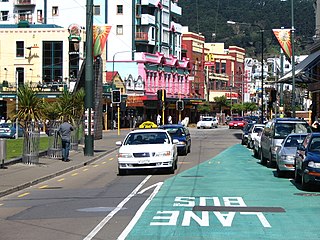
Te Aro is an inner-city suburb of Wellington, New Zealand. It comprises the southern part of the central business district including the majority of the city's entertainment district and covers the mostly flat area of city between The Terrace and Cambridge Terrace at the base of Mount Victoria.

Wellington railway station, or Wellington Central station, is the main railway station serving Wellington, New Zealand, and is the southern terminus of the North Island Main Trunk, Wairarapa Line and Johnsonville Line.

The Hotel St. George was once one of Wellington, New Zealand's top hotels. It is a significant building on a prominent corner site.
Wellington City Libraries is the public library service for Wellington, New Zealand.
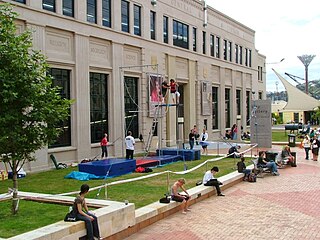
City GalleryTe Whare Toi is a public art gallery in Wellington, New Zealand.
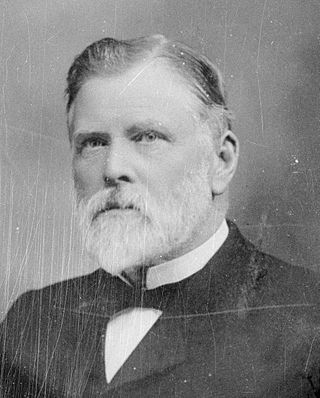
John Duthie was a politician and businessman in New Zealand. Originally from Scotland, he came to Auckland in 1863. He set up his own ironmongery in New Plymouth, then Wanganui, and he finally settled in Wellington. In the latter city, he was mayor for one term. He then represented Wellington in Parliament for a total of eleven years. For the last two years of his life, he was appointed to the New Zealand Legislative Council.
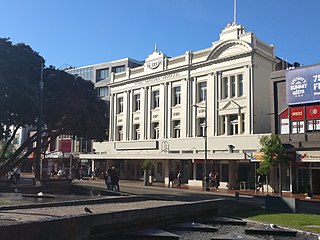
The Opera House is a proscenium theatre in Wellington, New Zealand, located on Manners Street opposite Te Aro Park.

St Mary of the Angels is a Catholic church on the corner of Boulcott Street and O'Reily Avenue in Wellington, New Zealand. It is the parish church for Wellington Central and one of the major churches of the city. The Marist Fathers have provided clergy for St Mary of the Angels since 1874 in succession to its founding and long-serving parish priest, the Capuchin Franciscan, Father Jeremiah O'Reily. The church was used by Archbishop O'Shea as his pro-cathedral (1936–1954). It was the site of the funeral of Suzanne Aubert in 1926 and is well known for its church music tradition.

The Dominion was a broadsheet metropolitan morning daily newspaper published in Wellington, New Zealand, from 1907 to 2002. It was first published on 26 September 1907, the day New Zealand achieved Dominion status. It merged with The Evening Post, Wellington's afternoon daily newspaper, to form The Dominion Post in 2002.

Sir Edward Michael Coulson Fowler was a New Zealand architect and author who served as mayor of Wellington from 1974 to 1983.
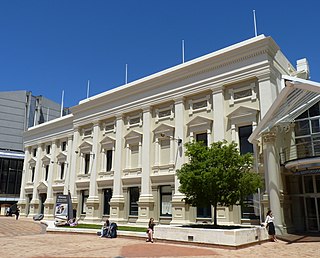
The Wellington Town Hall is a concert hall and part of the municipal complex in Wellington, New Zealand, which opened in December 1904. It has been closed to the public since the 2013 Seddon earthquake for extensive strengthening work, and projected to reopen in January 2025.

Kirkcaldie & Stains was a department store in Wellington, New Zealand. It was established in 1863 by John Kirkcaldie and Robert Stains with a capital of £700. The first store was opened on Lambton Quay. In 1868 Kirkcaldie & Stains moved to their final location at the corner of Lambton Quay and Brandon Street, expanding several times. There was a branch on Cuba Street, Wellington from 1870 –1876 and one in Napier from 1897 until 1917. French luxury skincare brand Sisley was exclusive to the store in New Zealand.

Gordon Wilson Flats is a residential building in central Wellington, completed in 1959. The building was owned by Housing New Zealand and housed 131 people. It is currently owned by Victoria University of Wellington, and is unoccupied pending a decision on its future.

Dr Henry Pollen's House is a historic building in Wellington, New Zealand. The house was built in 1902 for Dr Henry Pollen as a residence and surgery. It was designed by William Turnbull. It was originally located at 12 Boulcott Street but was moved by crane to the corner of Boulcott Street and Willis Street in 1988 to make room for the Majestic Centre. The building was also reoriented by about 90 degrees to fit on its new site.




















